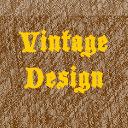 What is vintage design? Vintage Design uses design elements that are “old-fashioned” or vintage. It focuses on design elements that were popular during the 1950s to 1980s or even older. You can create an old-fashioned motif by incorporating specific fonts, colors and graphics from a selected era. By using these specific design elements on your website, you can achieve a look that won’t be considered boring.
What is vintage design? Vintage Design uses design elements that are “old-fashioned” or vintage. It focuses on design elements that were popular during the 1950s to 1980s or even older. You can create an old-fashioned motif by incorporating specific fonts, colors and graphics from a selected era. By using these specific design elements on your website, you can achieve a look that won’t be considered boring.
While researching Vintage Design for a client, I found the following articles:
- Retro and Vintage In Modern Web Design Smashing Magazine defines what retro and vintage design is. They show you the specific design elements that make up the look and provide examples so that you can create websites using Vintage Design.
- Vintage Design may use aged or Old-fashioned photos. You can achieve the Old fashioned Photo Effect with modern photos. Change your photos using Photoshop to look like vintage photographs.
- Another aspect of Vintage Design is how the backgrounds look. The backgrounds look aged, dark or stained. You can find some Vintage Retro Backgrounds to incorporate your designs.
- WebDesignShock has a collection of 175 Vintage and Retro Design Elements. Their collection includes icons, patterns, backgrounds, fonts and more. You can download them in PSD format for including in your websites.
- Vintage Design is not complete without fonts that help transport you to the past. WebDesignLedger has collected 30 Fonts Perfect for Vintage and Retro Style Design. Use these fonts to complete the old-fashioned look that you want.
For additional inspiration, check out 50 Retro and Vintage Web Designs to Inspire You.

